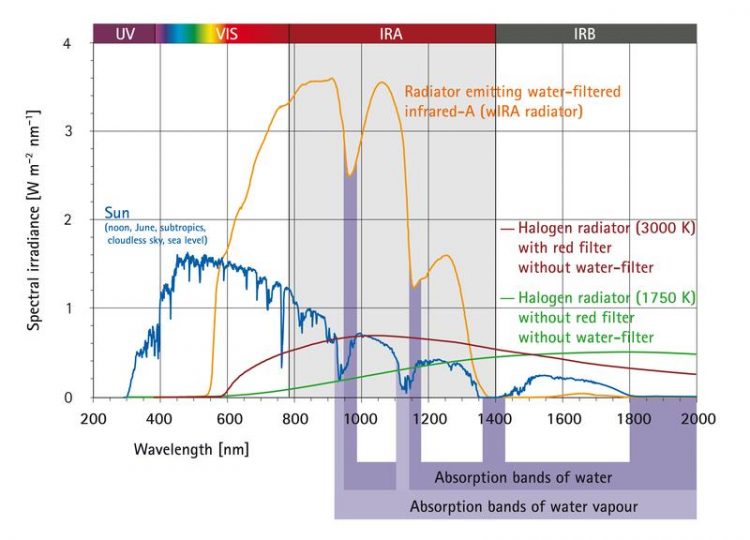Heat for wounds – water-filtered infrared-A (wIRA) assists wound healing

Comparison of the spectra of the Sun and of two different halogen radiators without water-filter: the three radiators with their spectral irradiances cause the same skin surface temperature G. Hoffmann
The results of 7 clinical studies (the largest study with 400 patients) about water-filtered infrared-A (wIRA) for wound healing have been published on 29.06.2016 as comprehensive review in the interdisciplinary e-journal “GMS German Medical Science” of the Association of Scientific Medical Societies (AWMF) [1].
The six included randomized controlled clinical trials compare a combination of high standard care plus wIRA treatment vs. high standard care alone.
wIRA increases tissue temperature (+2.7°C at a tissue depth of 2 cm), tissue oxygen partial pressure (+32% at a tissue depth of 2 cm) and tissue perfusion.
wIRA promotes normal as well as disturbed wound healing: wIRA diminishes inflammation and exudation, wIRA promotes infection defense and regeneration, and wIRA alleviates pain. During 230 irradiations without any exception an alleviation of pain was observed with a substantially reduced need for analgesics (52–69% less in the three groups with wIRA compared to the three control groups without wIRA after major visceral surgery, nearly 60% less need for analgesics in chronic venous stasis ulcers).
Further effects are:
– Faster reduction of wound area (in severely burned children: 90% reduction of wound size after 9 vs. 13 days, after 9 days approx. 89% vs. approx. 49% reduction in wound area, complete wound closure of chronic venous stasis ulcers after 14 vs. 42 days).
– Better overall evaluation of wound healing.
– Better overall evaluation of the effect of irradiation.
– Better cosmetic result.
– Lower wound infection rate (single preoperative irradiation: 5% vs. 12% wound infections in total, of these: late wound infections (postoperative days 9-30) 1.7% vs. 7.7%).
– Shorter hospital stay (discharge after 9 vs. 11 postoperative days).
The effects of wIRA are compiled with extensive numerical data in a table of several
pages and illustrated with figures.
Water-filtered infrared-A is a useful complement for the treatment of acute and chronic wounds.
Publication (freely available):
[1] Hoffmann G, Hartel M, Mercer JB. Heat for wounds – water-filtered infrared-A (wIRA) for wound healing – a review. GMS Ger Med Sci. 2016;14:Doc08.
DOI: 10.3205/000235, URN: urn:nbn:de:0183-0002352
Publication online freely available as PDF and shtml from:
http://www.egms.de/en/journals/gms/2016-14/000235.shtml
Extensive presentation of a variety of applications of water-filtered infrared-A (including applications besides wound healing) in German language is freely available from:
http://www.waerme-therapie.com/fachartikel.html
http://www.egms.de/en/journals/gms/2016-14/000235.shtml as HTML-file
http://www.egms.de/static/pdf/journals/gms/2016-14/000235.pdf as PDF-file
Media Contact
All latest news from the category: Health and Medicine
This subject area encompasses research and studies in the field of human medicine.
Among the wide-ranging list of topics covered here are anesthesiology, anatomy, surgery, human genetics, hygiene and environmental medicine, internal medicine, neurology, pharmacology, physiology, urology and dental medicine.
Newest articles

High-energy-density aqueous battery based on halogen multi-electron transfer
Traditional non-aqueous lithium-ion batteries have a high energy density, but their safety is compromised due to the flammable organic electrolytes they utilize. Aqueous batteries use water as the solvent for…

First-ever combined heart pump and pig kidney transplant
…gives new hope to patient with terminal illness. Surgeons at NYU Langone Health performed the first-ever combined mechanical heart pump and gene-edited pig kidney transplant surgery in a 54-year-old woman…

Biophysics: Testing how well biomarkers work
LMU researchers have developed a method to determine how reliably target proteins can be labeled using super-resolution fluorescence microscopy. Modern microscopy techniques make it possible to examine the inner workings…





















